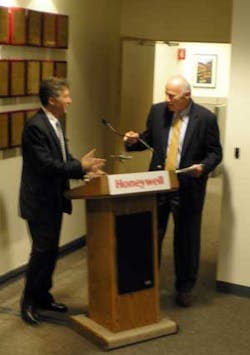Inside the history of Honeywell and ADEMCO
On Tuesday, May 21, 2008, Honeywell dedicated a new museum to the company's history in security and intrusion products. The museum, which houses products dating as far back as 1929, features old ADEMCO catalogs, early alarm contacts, some of the original home automation equipment, and of courses, lots of historic burglar alarm control systems.
The museum, which was dedicated by Honeywell Security and Custom Electronics President Ron Rothman, is located in the company's new Melville, N.Y., office. On hand for the dedication were Leo Guthart (former chairman/president of ADEMCO, and responsible for building ADEMCO/Honeywell into the company it is today in the intrusion alarm market), Honeywell Security CEO Ben Cornett, a number of members of the First Alert President's Council representing some of the largest alarm firms in the U.S., as well as various security industry trade media.
The museum, which encompasses just a couple hundred of square feet inside Honeywell Security's New York metro headquarters, brought back memories for the First Alert dealers, Guthart and Rothman, as they pointed to different technologies they could still vividly recalled. Asked if any stood out, Guthart noted that the 527 smoke detector from 1966 was the device that served as a precursor to their entry into the more modern ionization-based detectors which they sold under the First Alert brand. The museum takes the history of ADEMCO back to 1929, when Maurice Coleman, who was running a hardware store, had just started building custom alarms for business.
"The museum memorializes the history of this company, which essentially memorializes the entire industry," said Guthart. As they watched the business grow, they had to overcome technology scalability issues. ADEMCO also was in the electronics industry as the switch occurred from mechanical relays to compact circuit boards. It presented new opportunities and new challenges for the company, said Guthart.
"It really was the early days of the electronics business," he said. "You might find you could build one unit and it would work great, but then you put a million together in an overseas factory, and it was an entirely different business."
It was at the same time that Honeywell/ADEMCO developed their in-house quality assurance (QA) division, which is located three doors away from the museum in the same Honeywell Melville, NY, building.
At Honeywell QA, you can find the company bombarding equipment with the equivalent of lightning strikes and in the same room you find techs in white lab coats holding devices shaped like the ray-guns of 1960s sci-fi films. The lab techs are giving repeated static electricity shocks to alarm keypads and control panels, something that equipment is regularly affected with in its daily usage. Around the corner is a room filled with video surveillance equipment, running 24/7 to find the kinks in cameras and DVRs. In another room, you find Long Island's biggest microwave oven; it's big enough for a dozen people to stand inside at one time. Inside the room, the QA testers are trying to find out how much random RF energy these electronic security devices can withstand. Fifteen steps away, there's the sound of rain, but it's actually a Honeywell dome camera being subjected to a weather-proofing test. In the midst of this is a "drop test" area to see how product packaging can withstand a ride in a UPS truck, in the back of an installer's van and the assorted accidents, bumps and drops that a package might go through along the way. You also find a shake test where the product is being rattled by a massive vibrating machine, and the Thermotron, where equipment is tested to see how well it withstands heat and humidity.
"Our systems get installed in the worst environments, places like basements and attics, and they have to work every time for 10 or more years because they are life-safety devices," noted Rothman as he showed the Thermotron. The company has set up the QA division so that the group doesn't report to engineering or to manufacturing; that organizational structure allows the group to truly be independent in their tests. "Otherwise, it would be the classic case of the fox guarding the hen house," added Rothman.
Also part of the living history at the facility, which Honeywell moved into in July 2007, is the AlarmNet data center which processes out signals to 500 central stations. Nearby is the Marketing division, responsible for First Alert ads, technology brochures and more. The engineering department can be found in the same building; it's loaded with people coding and soldering circuit boards. They're trying out a variety of products like biometrics for arming systems, new high-tech styled keypads, and false-alarm minimizing exit sensor technology.
Along on the tour through engineering were a number of members of the First Alert President's Council, which is comprised of the top First Alert dealer companies. As the First Alert dealers gravitate toward new technology prototypes and as Rothman takes notes on what has piqued their interest, it's clear that -- even though the museum is now opened and dedicated -- the history of Honeywell's intrusion business is far from finished.
